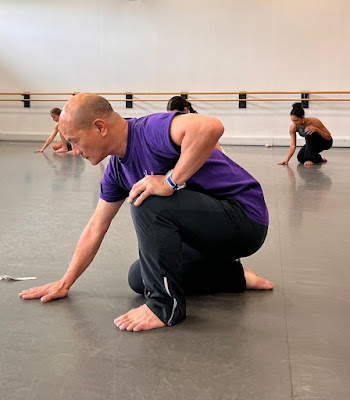I had the pleasure of teaching my inaugural Adult Beginner Ballet class at Taylor Dance West, with three lovely dancers who were a joy to get to know through their dancing! It is a class about basics, and even if you did once take ballet classes in the past, there are so many different styles and technical approaches. So my approach is to get back to the basics of why we even use the actions, shapes, and movements that are essential to ballet and many dance forms.
I started taking ballet lessons from a young age, and I have often marveled at how comforting the structure of starting at the "barre" (that horizontal support you see dancers holding on to in so many studio pictures) has always been for me. Maybe it harks back to holding a parent's or a friend's hand as you explore the world, and it makes you feel secure while learning a new way to approach moving, and getting to know your own body. It is also a big help when getting your body used to standing and balancing on one leg!
 |
| "2023 Eliot Smith presents Paul Taylor" - thanks at the end of class. photo: Eliot Smith |
NOTE: Ballet terms are mostly in French, and I will try to provide a descriptive term in English in an effort to not have my readers or dancers in class have to use their universal translators!
"Pliés" or "knee bends" are often the way ballet classes begin, and it is the most basic of actions we take with our legs for almost everything we do to move in space and transition from one position to the other. When I teach modern classes, I end with giving "thanks" by having all the dancers kneel with me in gratitude for the time, space, musicians, and everyone in the room. In ballet class, we also end with a "reverence" or thankful gesture that would formally include a bending of the knees or body in some way.
Incorporating pliés and their varying uses throughout class explores the many ways that this simple bending of the knee(s) can propel our weight through space, whether it is to set us up to balance and turn, or to travel around the studio. And in class, you will often hear me remind you of how to use your plié in the myriad ways it helps us to dance.
The very last thing you hear Jacqueline Moreau say is, "Don't be afraid to fail the exercise". I love that sentiment.When I speak of positions in ballet, there are five basic standing positions with your weight on both feet most often described. These positions are so fundamental to the many different styles of ballet, that many dancers take them for granted, but instantly recognize their use when walking into any ballet class. I have always loved this poster from around 1974 for New York City Ballet (NYCB). It was designed by Edward Gorey, who was a much lauded artist and illustrator, and who loved going to the ballet. Mr. Gorey also happened to love many of Paul Taylor's dances and had been spotted often at our performances at City Center through the years.
The common knowledge of ballet for followers of NYCB precluded the need to include the classifications that the positions of the feet on the floor are (from top to bottom):
First. Second. Third. Fourth. Fifth.
I look forward to posting about once a week moving forward, and if you have any questions about my classes, please feel free to comment below.
Thank you for being here!





No comments:
Post a Comment